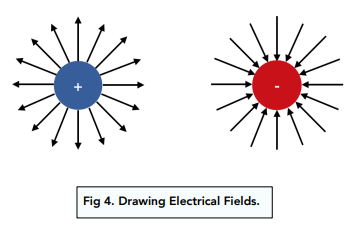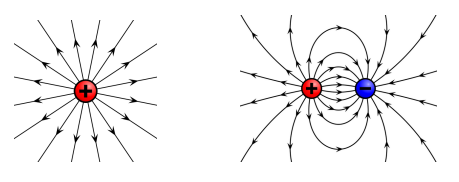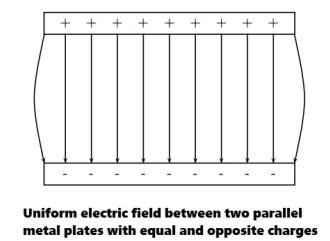Drawing Electric Field Patterns (GCSE Physics)
Drawing Electric Field Patterns
Drawing Electric Field Patterns
Important Rules
For exams, we need to be able to draw the electric field patterns. There are a few important rules to remember:
- Field lines are drawn as straight lines from a charged particle (like the spokes of a wheel).
- Field lines always point from positive to negative.
A positively charged sphere will have the field lines pointing away from it.
A negatively charged sphere will have the field lines pointing towards it.

Examples of Electric Field Patterns
Radial Electric Fields
A conducting sphere with a positive charge would repel other positive charges. This means that the arrows point away from the positively charged centre. This demonstrates a radial electric field.

If we were to place a negative charge in the field, seen in the diagram above, a force in the opposite direction to the field lines would be created as the negative charge is attracted to the positive charge.
Uniform Electric Field
Two parallel metal plates with equal and opposite charges would form a uniform electric field, where the field lines are parallel and point from positive to negative.

Electric Field Patterns are a representation of the distribution of electric field lines in a given area. These patterns are used to visualize the strength and direction of an electric field, and can help to understand the behavior of charged particles in that field.
Drawing Electric Field Patterns is an important skill in physics because it allows you to visualize the behavior of charged particles in an electric field. This understanding can help you to make predictions about how charged particles will move and interact in the field, which is important for a wide range of applications, from electrical circuits to medical imaging.
To draw Electric Field Patterns, you start by identifying the charges that are present in the field. Then, you use the direction of the electric field lines to determine the direction of the force that would be experienced by a positive test charge placed in the field. The strength of the field can be determined by the number of field lines that are drawn per unit area.
There are several rules that must be followed when drawing Electric Field Patterns:
Electric field lines always point in the direction that a positive test charge would move
The number of field lines that pass through a unit area is proportional to the strength of the field
Electric field lines cannot cross or intersect
Electric field lines always originate from positive charges and end on negative charges
The direction of the Electric Field Lines is determined by the direction that a positive test charge would move in the field. This direction is away from positive charges and towards negative charges.
The charge of an object affects its Electric Field Pattern because it determines the direction and strength of the field. A positive charge creates an electric field that points away from the charge, while a negative charge creates an electric field that points towards the charge. The strength of the field is proportional to the magnitude of the charge.
The Electric Field Pattern provides information about the direction and strength of the electric field, which determines the behavior of charged particles in that field. Charged particles will experience a force in the direction of the electric field, and their motion will be influenced by the strength of the field. Understanding the Electric Field Pattern can help to make predictions about the behavior of charged particles in the field.





Still got a question? Leave a comment
Leave a comment